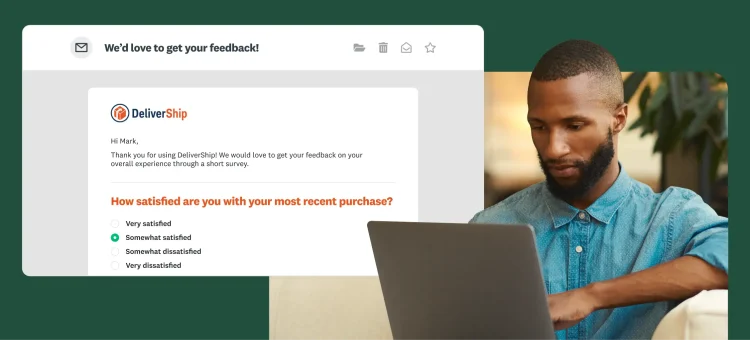Let’s face it: Gathering feedback right when you need it can feel overwhelming. But in a world driven by data, it's even more important to be methodical about collecting insights. The good news? Learning how to create a free survey has never been easier. However, there are still challenges and best practices you need to know to create an online survey. That's where SurveyMonkey quickstart guides come in.
In this article, we'll explore how professionals in HR, marketing, and market research can get started with surveys and feedback projects quickly. We'll dive into the unique challenges faced by each role, and provide practical tips for getting started.
Let’s get into it.
For HR professionals: How to start getting employee feedback quickly
If you work in HR today, your work probably isn’t limited to your job description. Over half (53%) of the HR pros we surveyed said they have more responsibility and can make a greater impact than ever before. For all that you do, having the right tools in place for employee feedback can help drive change—whether you’re looking to improve the employee experience or demonstrate the strategic value of HR in driving business outcomes.
By regularly collecting employee feedback and generating survey data, you can make a real impact on high-level decision making that affects the entire business. Leveraging your findings, you can identify areas for improvement, measure the impact of HR initiatives, and provide valuable insights to leadership.
Here are a just a few of our tips on how to create a survey:
- Establish a regular feedback schedule: Establish a regular cadence for feedback, such as surveys that measure annual engagement, quarterly pulse checks, or post-company events.
- Create a central, secure source for employee insights: Ensure that sensitive employee data is kept confidential and easily access and analyze insights across different surveys and time periods.
- Collect feedback through the tools employees use every day: Since SurveyMonkey integrates with the business intelligence tools HR leaders use every day, you can collect feedback through email, company intranet, or chat tools like Slack. This reduces friction and increases the likelihood of receiving timely, relevant feedback.
Check out our HR quickstart guide for a more comprehensive overview of how to start getting feedback for every stage of the employee lifecycle, including survey templates for employee engagement, onboarding, exit interviews, and more.
For marketers: How to start getting customer feedback quickly
Marketing in the current business landscape is competitive, and the pressure to stand out is only getting stronger. According to our marketing trends report, 73% of marketers expect to face more competition in 2024, a 19-point increase over last year.
Surveys can play a critical role in helping you stay ahead of the competition. Gathering feedback gives you an inside track into customer preferences, changing expectations around customer experience (CX), and more. Survey data can inform marketing strategies, help optimize campaigns, and improve brand perceptions. Surveys also provide a way to measure the effectiveness of your efforts, demonstrating ROI to key stakeholders.
Here are a just a few of our tips on how to create a survey:
- Identify customer touch points and channels to gather feedback from: Consider the entire customer journey and determine the most important moments where feedback would be valuable. Prioritize channels that our customers and prospects frequently use.
- Choose a mix of survey types for comprehensive insights: Different survey types offer unique perspectives on customer satisfaction and loyalty. By combining metrics like Net Promoter Score® (NPS), Customer Satisfaction (CSAT), or Customer Effort Score (CES), you can gain holistic understanding of how customers perceive brand and identity areas for improvement.
- Regularly analyze and share the ROI of marketing efforts: Set up a consistent process for analyzing survey data and translating insights into actionable recommendations. Regularly share these findings with relevant teams and stakeholders to ensure that customer feedback is driving marketing decisions and helping to demonstrate the value of your efforts.
Read our quickstart guide for marketers for a more strategic overview of how to start a customer feedback program, including survey templates for key CX metrics like NPS, event feedback, product development, and more.
For market researchers: How to start a customer feedback program quickly
Market research is crucial for businesses to stay competitive and make informed decisions, but the landscape is becoming increasingly complex and fast-paced. According to our Market research trends report, 92% of market researchers are concerned about job security in 2024, a 29 percentage-point increase over last year.
With the help of surveys, market researchers can explore new market opportunities, test hypotheses, and efficiently gather data from target audiences. In addition, survey-based research provides a scalable, cost-effective way to monitor market trends, inform product development decisions, and more. Through these insights, market researchers can stay ahead of the curve.
Here are a just a few of our tips on how to create a survey:
- Align your research objectives with business goals: Before launching a survey, carefully consider how your research goals will support the bigger picture. This will help you design a more targeted and effective survey.
- Use AI to build and analyze surveys faster: SurveyMonkey Genius streamlines survey creation and analysis with AI to help you write surveys in minutes, recommend question types and answer choices to eliminate bias, and automatically categorize open-ended responses by sentiment, allowing you to focus on interpreting insights and making data-driven decisions.
- Produce compelling research reports using key reporting tools and integrations: Use reporting tools that enable you to create visually engaging and easy-to-understand reports. Survey data can be integrated with other platforms to provide a more comprehensive view of customer insights and market trends.
To get more of a strategic overview of how to start a customer feedback program with survey templates for MaxDiff analysis, concept testing, ad testing, and more, read our Quickstart guide for market researchers.
Starting a feedback program doesn't have to be complicated. With our quickstart guides, you can hit the ground running and start gathering valuable insights in no time. Whether you're an HR professional looking to improve employee engagement, a marketer seeking to understand your customers better, or a market researcher aiming to stay ahead of the curve, the guides listed above have you covered.



